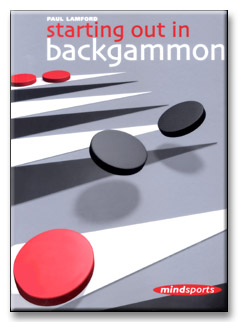| |

|
Starting out in Backgammon
Paul Lamford
|
Backgammon's newfound popularity in our modern computer world is evident in the rich diversity of Internet game servers, and the steady stream of new publications dedicated to the game. Paul Lamford is a multi-skilled and highly rated British player of strategy games; in fact he's a former British Champion of both Backgammon and Bridge. Suffice to say the author is a well-qualified and experienced authority.
This book marks Lamford's second venture into the backgammon literary market, following in the footsteps of his successful Intermediate/Advanced text, 100 Backgammon Puzzles. Perhaps, mirroring the Star Wars formulae, this second publication could be viewed as a prequel to his inaugural publication and the two texts would certainly work well as a total package.
Starting Out is obviously targeted squarely at the Novice/Beginner readership, though casual players or those already versed in backgammon variants would find the book an efficient and effective introduction to the formal game.
Despite the adage "Never judge a book by its cover," a quick glimpse of the exterior design provides an abstract insight into the style of the book: slick; hi-tech; and brilliantly simple — a theme effectively sustained throughout the 12 Chapters. Paul obviously knows his A.B.C's — Accuracy Brevity and Clarity.
The prose is easy to read, the contents logically structured, the illustrations are well presented and feature the modern standard notation. In short, just what you would expect from the editor of a popular games and puzzles magazine. Echoing the style of the flourishing "For Dummies" type publications, each chapter is peppered with handy "Tips," and "Warnings," and "Notes." which boldly summarize the salient points in clear memorable sound bites. Each instructional chapter ends with a small quiz for the readers to test their understanding of some of the issues discussed.
As hinted by the cover, the tactical and strategic advice reflects the modern game as defined by the advent of the neural network backgammon programs. You won't find any discrepancies with Snowie in this Beginner's manual (unless expressly stated otherwise by the author eg in the 'Backgames' chapter). Lamford has made judicious use of rollouts to verify the accuracy of his instructions.
Readers are sequentially introduced to the basic objectives and tactics of the game, then progress through: the opening rolls; race considerations; bear-offs; and into the distinct strategies characteristic to priming, blitzing, holding, and backgames. Eight pages are dedicated to elementary cube theory, which features the author's brilliantly simple PRAT — "Position Race And Threats" concept.
Doubling theory is periodically elaborated throughout the book culminating in a brief discussion on the significant differences between 'money' and 'match' play considerations. The book closes with descriptive sections on Internet and computer backgammon. The obligatory probability tables, glossaries and a select bibliography are appended to the book.
Despite the easygoing text, backgammon is a highly complex game and Novice readers are unlikely to soak up the wealth of information on the first pass. Periodic revision of the information will reward the keen reader, and the layout facilitates fast location of important information. I envisage that the book would facilitate a swift passage to the Intermediate level for the average novice player.
I found the prose to be somewhat impassive, in comparison to more dynamic wordsmiths of the 1970's such as Barclay Cooke, or Don Stern. At times, the author seems to be preaching to the converted. His efforts to sell the game on points such as the fun factor, heritage and rich tactical complexities etc are disappointingly confined to the realm of mediocrity. I was mildly surprised that the author neglected to encourage the reader to put their newly acquired knowledge to the test at a local tournament or club, despite devoting six pages to self-improvement in the virtual realm. A sign of the times perhaps?
In my opinion, the main chapters would be considerably enhanced by additional reference problems to augment the scant quiz sections, perhaps a minimum of ten for each game type. Smaller board diagrams for the quiz positions might have enabled more of such material to be crammed into the instructional package.
The relatively modest information on the back cover, assures the prospective gamester: "Learn Backgammon from scratch or brush up on the basics ... An ideal Backgammon book for players of all ages." The publication certainly lives up to this promise. Virgin players and newcomers to formal backgammon are assured a rewarding read from Lamford's "Beginners book for the new millennium."



![]()
